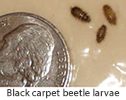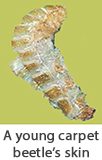Identification and Life Cycle
Carpet beetles belong to the family of beetles known as Dermestids. There are three common types most frequently encountered in New York State: The Varied Carpet Beetle, Furniture Carpet Beetle and Black Carpet Beetle.
The adult Black Carpet beetle (Attagenus Megatoma) has a dull black body about ¼ inch long with brown antenna and legs. The larvae’s body is carrot-shaped with golden brown hair and a long tail.
The other two species, the Varied Carpet beetle (Anthrenus Scrophulariae), and the Furniture Carpet beetle (Anthrenus Flavipes) can be very difficult to tell apart because their appearance and habits are alike. Both adult species are less than ¼ inch in length, and have a pattern of scales; dull white, yellow, dark gray and a reddish brown. The larvae are covered with long, dark brown hairs.
Carpet beetles develop an uninterrupted cycle in areas of the home where temperatures are held at a comforting warm level throughout the year. Each female carpet beetle may lay 30 to 100 eggs. Eggs usually are laid on clothing, on lint in cracks, in dusty heating vents or on dead insects that have accumulated inside light fixtures. The adult beetles, after laying their eggs move outdoors to feed on flower pollen. The eggs hatch within 2 weeks and the larvae now begin their descructive feeding for up to 9 months. The young carpet beetles avoid light during this period of growth and occasionally shed their skins as they develop.





Comments are closed.